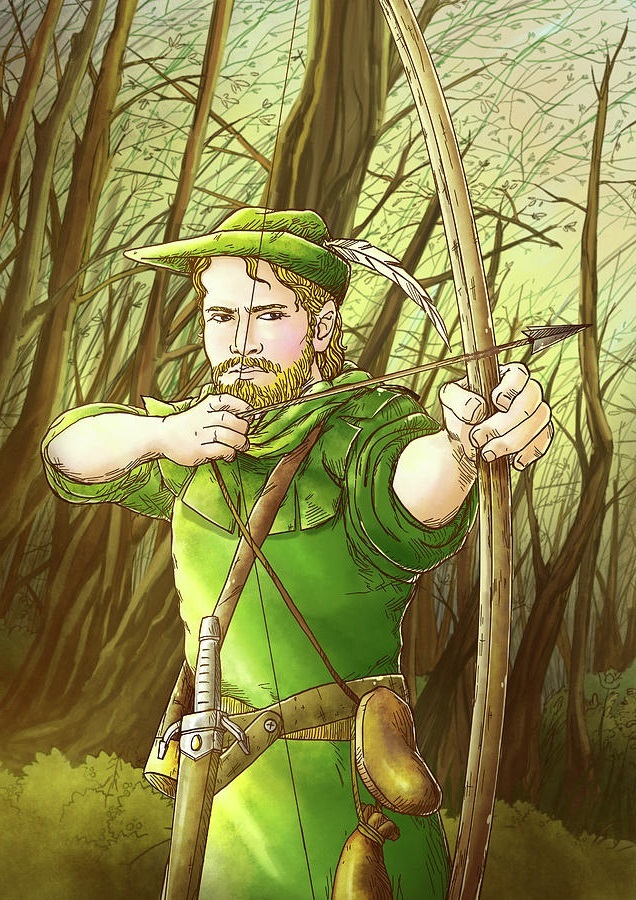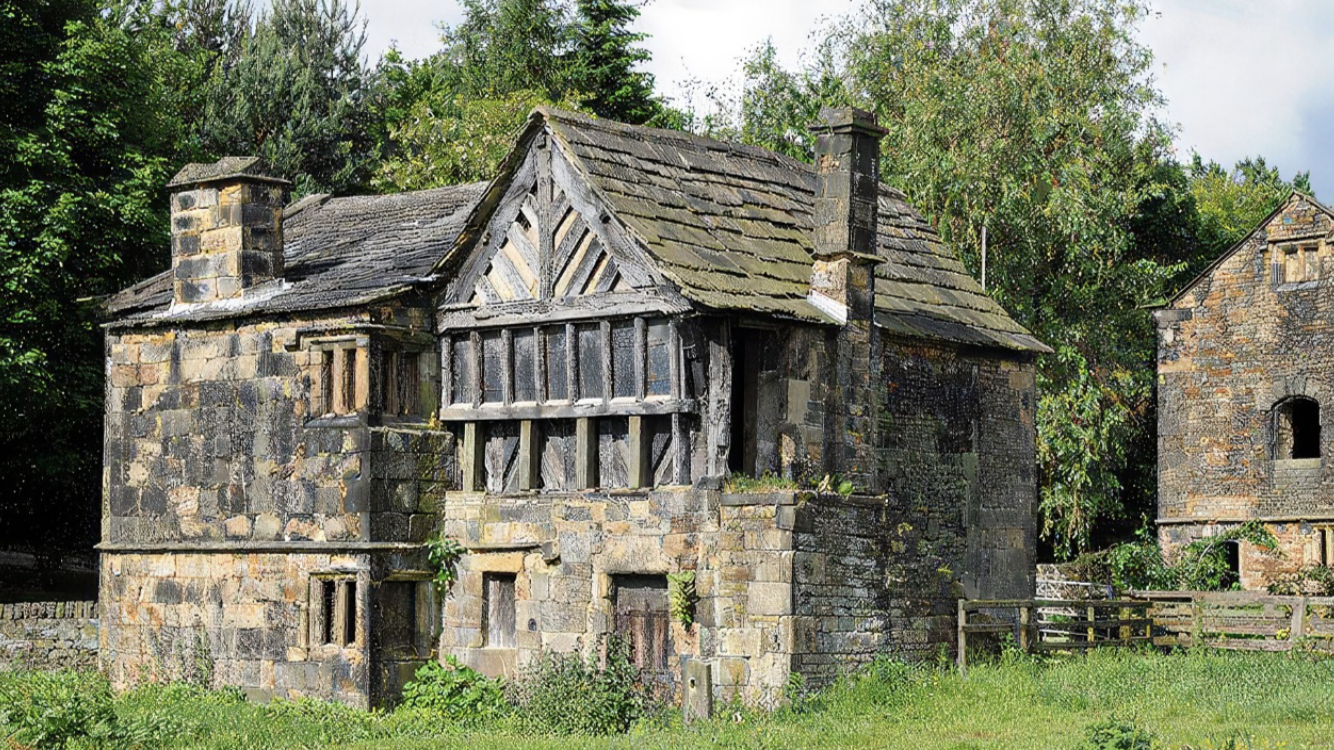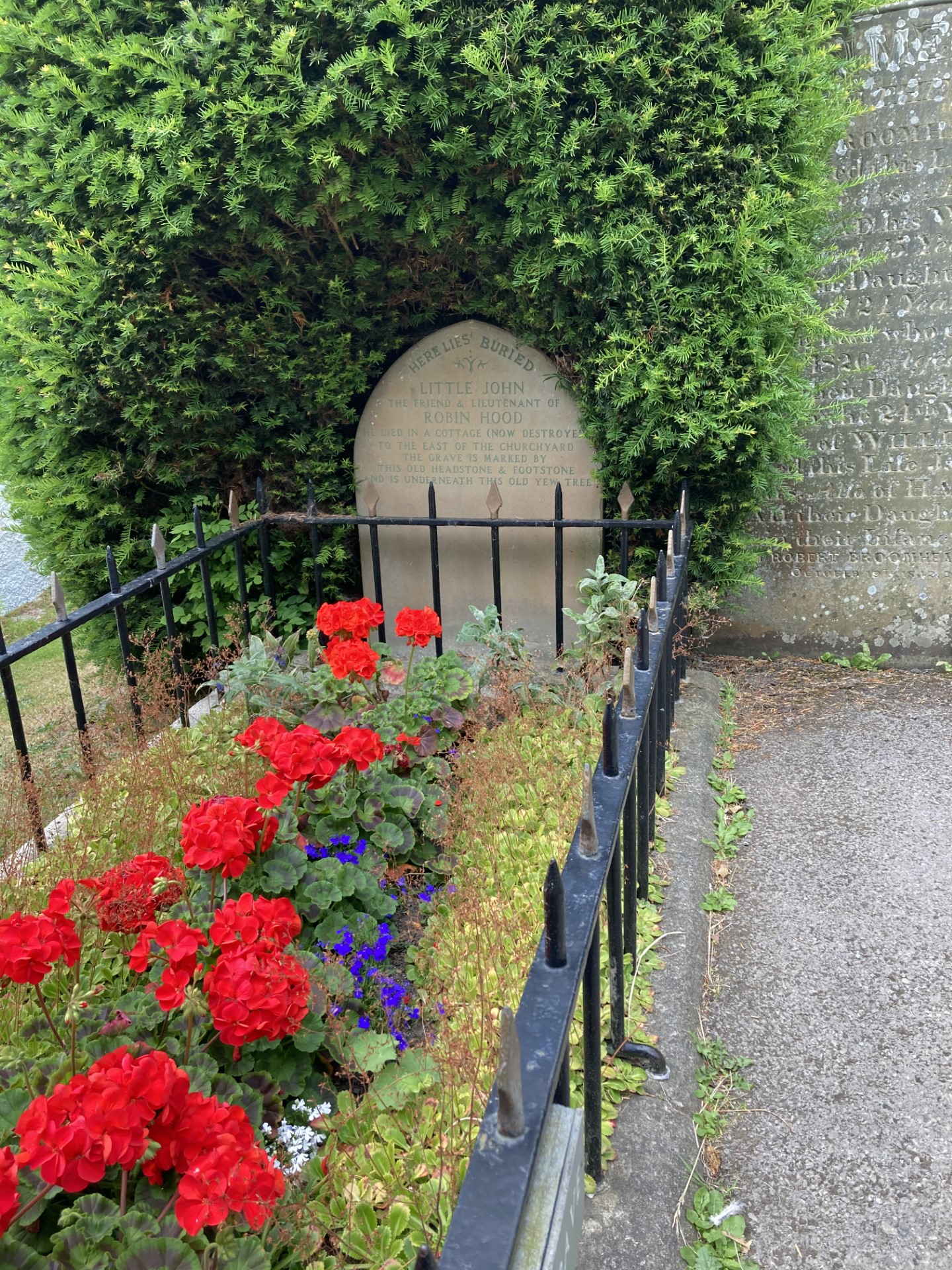
Did Robin Hood Really Exist?
Well yes, but there were actually two of them.

The Robin of legend is a composite of two real men with
almost
identical names, who lived 120 years apart.
Now for me this subject carries a little nostalgia, not only because my
auntie Norah used to buy me Robin Hood books and toys but also because the
entire saga took place in my own backyard, geographically speaking.
I was born and raised within 28 miles of Sherwood Forest at its present extent, actually inside it when we retrace its medieval limits, and I'd spend many a weekend picnicking there during my childhood, making bows and arrows with nought but switches, a penknife and a length of string.
And naturally the question would arise, 'Did Robin really exist?'
Well until the middle of the nineteenth century all we had on him was the early ballads and stories, the most ancient of which is The Little Gest of Robin Hood which first appeared in 1377. Now for a long time these were not written down, but performed in the ale houses and taverns, either by oral recital or musically. The various tales which were circulating at that time all paint a picture of a tough, hardened man who led a band of outlaws and thieves and used the forest as a refuge. He was a yeoman, a freeman but he had no title. And he was of course, very famously, an archer who wore Lincoln green.
The general background theme of these early stories is that Robin takes refuge in the greenwood (for some reason which is not mentioned) before being pardoned at a meeting, in a clearing in the forest, by 'Edward, our comely king' (er...who? Edward? Wasn't he Richard the Lionheart? Read on...). He is then invited to work at Edward's court in London as one of the king's personal bodyguards, but after about 15 months he feigns illness, lamenting that 'if I dwell longer with the king, then sorrow shall me slay.' He is then discharged as no longer able to work, and returns to his beloved Barnsdale (hold on...where?) That's Barnsdale Forest in Yorkshire, Robin's original haunt in all the ballads. It's just north of Sherwood. He also has a wife called Matilda, who in turn has a cousin called Elizabeth de Staynton who was prioress of Kirklees Priory near Wakefield in Yorkshire, a place which really existed and the ruins of which are still there today.
However, far from being an endearing character he once robbed a traveller before killing him and then, sticking the man's head on a pole, hacking his face to shreds with a knife, and he commits acts of violence pretty much throughout the ballads. But at the same time he was not without piety; he doted upon the Virgin Mary and as these ballads were performed scarce a stanza would pass without some mention of her. His one really endearing quality, though, was his enmity towards the abbot and monks of St. Mary's in York (which also exists; the ruins can still be visited) who owned vast tracts of land in those days and charged rents which the poor tenants could ill afford to pay. Upon their part, rapacity was the order of the day and in those Catholic, pre-Reformation days of salvation by the shilling they had grown rich, despite their own vows of poverty and their own church's maxim that it is better to give than to receive.
For their own subsistence, these cutthroats, for want of a more accurate word, preyed upon the commerce which passed along the Great North Road, or Ermine Street as it was then called (today the A1), especially the stretch which passed through not Sherwood Forest, but again Barnsdale Forest east of Wakefield. In fact there is no mention of Sherwood at all in any of these early works.
Now these ballads circulated widely in the north of England, but then in 1599 a playwright called Anthony Munday wrote a new play in which Robin was remodelled into a lord (of Loxley), who'd had his lands confiscated by Prince (later King) John after his brother Richard I had embarked upon the Third Crusade to the Holy Land. This Robin had a wife called Matilda, which she changed to Maid Marian (an obvious alias which means Virgin Mary, maid meaning virgin and Marian pertaining to Mary just as Edwardian pertains to Edward or Elizabethan to Elizabeth) when she joined him in the forest, which is now at last changed to Sherwood Forest. This Robin was also still an expert archer (despite now being a lord and therefore apparently not a trained archer), still wore Lincoln green, and still had the same band of followers. But where exactly did Munday get all this extra stuff?
Then, in the 19th century an antiquarian called Joseph Hunter was looking through the archive records preserved in the Exchequer in London when, lo and behold, in the personal accounts for not Kings Richard or John but for Edward II, (remember 'Edward, our comely king'?), he came across a Robyn Hode, who in 1323/4 had been a personal bodyguard to the king, who had worked in this position for just over a year, and had then been discharged with 5 shillings severance pay. Hunter concluded that these two men, this Robyn Hode and the Robin of the ballads, were one and the same, their details clearly confounding coincidence. Then, he further discovered that this Robyn Hode was almost certainly the same man as a Robert Hood of Wakefield, who was found in archive records in Yorkshire, having committed no less than 20 crimes between 1309 and 1322, including knife attacks, stealing firewood -- and highway robbery. Hunter decided to dig deeper.
He then discovered that immediately prior to the date of this employment there had been a battle, the Battle of Boroughbridge in 1322, in which the Earl of Lancaster, a first cousin of Edward II, had rebelled against the king, the longbowmen of his army having worn Lincoln green livery jackets. He had lost this battle and his followers had fled into nearby forests. Both this Robyn Hode and Robert Hood of Wakefield had apparently done the same thing, Hunter found, fleeing into Barnsdale Forest and, for those who might still believe that they were not the same man, they both took with them the same bunch of compatriots, whose names may sound familiar: a John the Little, a William Scathelok (who later became Will Scarlett), and the Earl of Lancaster's personal chaplain, a friar Thomas Tuck. Further, Robert Hood of Wakefield's wife, Matilda, who joined him in the forest, also had a cousin called, of all the names you can think of, Elizabeth de Staynton who was, lo and behold, none other than the prioress of Kirklees Priory.
Now all this was more than a coincidence by any code. But where did Munday get all this Lord of Loxley and Earl of Huntingdon stuff from? It wasn't mentioned in any of the early ballads and stories, nor did it seem to have any connection with this historical Robyn Hode/Robert Hood of Wakefield. Did Munday just make it up? Or was there perhaps an earlier Robin? Modern researchers such as Graham Phillips decided to delve even deeper.
Now there are two Loxleys, one near Sheffield in Yorkshire, which I know well because some of my family are buried in a vault there, and another in Warwickshire not far from Shakespeare's home town of Stratford. They were both villages in medieval times and the second Loxley still is, the first one having now been swallowed up by an expanded Sheffield so that it is now one of its suburbs. Now tradition has always ascribed the Loxley of Munday's play to the Sheffield Loxley but there was never any evidence that Robin Hood came from there, save for an obscure reference to a Robert Locksley who fled into the forest after killing his father. Nor has the Sheffield Loxley ever had its own manorial Lord.
However, the other Loxley is far more resonant with Munday's updated Robin. There was, back in the days of Richard the Lionheart, a Robert Fitz Odo, also called Robert Odd or Hodd. Now Robin is of course a nickname for Robert and so this man was probably called Robin Odd or Robin Hodd, which is not a case of stretching things too far on the part of modern researchers because this man was also the Lord of Loxley! However despite his status he was prosecuted for robbery and had his lands confiscated.
Having delved into this a little more deeply, it looks as though Munday, in progressing back through time to try base his play on some historical Robin, has missed the 1323 Robyn Hode/Robert Hood of Wakefield (later found in the archives by Hunter), and instead has followed an older scholar called John Major, who lived about 50 years before Munday and who had gone sailing back another 120 years and found this Robin Hodd of Loxley, whose name sounded near enough and who was an easier guy to trace due to his higher status. And at this point, Munday fused Robin Hodd of Loxley with the Robin of the ballads (which in turn are about Robert Hood of Wakefield), to create the Robin Hood of book and film.
And so, to summarise:
Robert Fitz Odo, probably called Robin Odd or Hodd, was lord of Loxley in the time of Richard the Lionheart, was prosecuted for being a 'plunderer', had his lands taken from him, but was not an expert archer, did not wear Lincoln green, was never in the service of a King Edward and didn't have the 'Merry Men'.
Robyn Hode of the Exchequer records and Robert Hood of Wakefield were almost certainly one and the same, lived 120 years later in the days of Edward II, was an archer, wore Lincoln green, was a yeoman, fled into Barnsdale Forest (the only forest mentioned in the early stories of Robin Hood), had the 'Merry Men', had a wife called Matilda who changed her name to Marian and who was a cousin of Elizabeth de Staynton the prioress of Kirklees Priory, but had no title and was nothing to do with Loxley.
Mix these two together, and we get the Robin of book and film as portrayed by Errol Flynn, Richard Greene, Sean Connery, Kevin Costner, Russell Crowe ....
So he's a composite. But in all fairness, Robert Hood of Wakefield/Robyn Hode was 'most of him', and therefore as a Yorkshireman I suppose I could say, albeit loosely, that Robin Hood was a fellow Yorkie.
--- Michael Alan Marshall

The room where Robin Hood (Robert Hood of
Wakefield) is said to have died.
He was murdered by his cousin in law Elizabeth de Staynton, prioress of Kirklees
Priory of which this building was the visitor lodge. She bled him to death in
1346/7 after he
went to her for medical help. We do not have a motive.

The grave of Little John at Hathersage in Derbyshire. The
probability of genuineness is very high. Recent research
has traced a John the Little who came from faraway Holderness, but had
details which closely match those
of the ballads. He knew William de Doncaster, the father of Roger de Doncaster
who was none other
than the lover of prioress Elizabeth de Staynton, both in ballad and real
history, and
in his retirement the same
John was
subsequently traced to this small village, of all places, which is otherwise unconnected
with the story. This grave has been known in this village since the 14th
century, which means that,
regarding the origin of the grave, "somebody knew something" 600 years
before the research was done.
When the grave was opened in 1784 the remains were found to be those of a person 6' 8" in height.
Notes
1) There is an ongoing mystery concerning Robin Hood's grave. An ornately carved stone was drawn in 1665, at which time it lay in its original position beside the road outside Kirklees Priory, where Robert Hood of Wakefield died. Elizabeth de Staynton, who murdered him in about 1347, said she moved his body to a grave beside the highway to reassure travellers who might pass that remote way. However that stone disappeared (a replacement was then chipped into small pieces which were sucked by the 19th century navigation canal builders as a cure for toothache), whereupon at length a Victorian fake tomb was constructed in nearby woods in the grounds of the priory.
Meanwhile -- and this is the mystery bit -- a gravestone, which curiously resembled the original one, turned up in the graveyard in faraway Loxley, that is, the Loxley of Robin Hodd in Warwickshire. Whether it is actually the same one, or a replica, cannot be determined. However it turned up there long before Joseph Hunter made his discoveries, and so, mysteriously, somebody may have known something connecting Robert Hood of Wakefield with Robin Hodd of Loxley.
2) Edward II, the 'Edward our comely king' of the earliest stories, was homosexual. Now, do you remember what Robin says in these ancient stories, about how sorrow would slay him if he didn't get away from the king? Reading between the lines, Robin Hood in contrast with such slim figures as Errol Flynn and Kevin Coster, was a big strapping lad. The longbow, England's wonder weapon, required such strength to draw back the bowstring that the archers were almost selective bred for the purpose, and there is also a stanza in one of the original ballads in which Robin carries a wounded Little John, himself a big strapping lad, on his shoulders. Is it possible that King Edward fancied big hunkies and that his band of bodyguards were also, unwittingly on their part, his male harem?
3) Sometime around the 16th century Robin first began to be described as the Earl of Huntingdon or Huntington. I have not covered this here as it is certainly untrue, that earldom having been in the hands of the Scottish royal family in the days of both Robins.
4) If you'd like to get into this, here's a well researched, reasoned documentary with Tony Robinson, one of Britain's best loved researchers on matters historical and archaeological. Was Robin Hood A Real Man In The Middle Ages? | Fact Or Fiction | Chronicle - YouTube